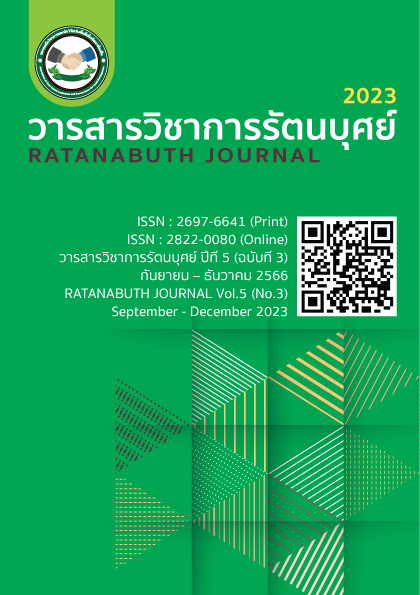The Achievements and Guidelines for Developing Teaching and Learning Management via Online System During the COVID-19 Situation of Mahamakut Buddhist University Yasothon Buddhist Callage Achievements and Guidelines for Developing Teaching and Learning Management via Online System During the COVID-19 Situation of Mahamakut Buddhist University Yasothon Buddhist Callage
Main Article Content
Abstract
This research aims to investigate satisfaction levels and instructional management approaches through online learning during the COVID-19 pandemic. It also seeks to assess the effectiveness of online instructional management and compare self-learning outcomes before and after utilizing online systems at the undergraduate level in Mahamakut Buddhist University Yasothon Buddhist College. This research employs a mixed-methods approach. The quantitative study used data from 261 people, and the qualitative study used data from 40 people. The research utilized questionnaires, group discussions, and in-depth interviews as research tools. Data analysis involved inferential statistics, including percentages, mean values (), standard deviations (
), checking for the range of scores, conducting t-tests, examining degrees of freedom (df), and determining significance values (Sig). The statistical analysis was performed using a pre-existing computer program. Qualitative data analysis included interpretation, analysis, synthesis, and explanation of findings through content analysis.
The research findings reveal that satisfaction with online instructional management during the COVID-19 situation is generally high (= 3.44,
= 1.85). The development directions for online instructional management can be reflected through the ability to observe, categorize, compare, and classify various environmental elements around oneself, as well as language proficiency, numeracy, knowledge, understanding of the environment, and experiences of various kinds. The educational management effectiveness should aim to foster individuals, create job opportunities, and contribute to the nation through an integrated and comprehensive education. Furthermore, it should aim to support and fund Thai intellectual resources and global intellectual resources. Additionally, there should be a focus on the impact on learners and efforts to elevate the workforce to a high-quality level through the development and cultivation of intellectual individuals. This intellectual development is categorized into two levels: namely Prachamethee and Prachayathibodi. Comparing self-learning ability before and after using online system, and comparing learning outcomes before and after using the online system, it was found that the learning effectiveness after using the online system (
= 74.86,
= 5.97) was significantly higher than before learning (
= 60.64,
= 5.24) at a statistically significant level of .05
Article Details

This work is licensed under a Creative Commons Attribution-NonCommercial-NoDerivatives 4.0 International License.
References
กนกวรรณ สุภาราญ. (2564). ทักษะครูกับการจัดการเรียนรู้ออนไลน์ยุคใหม่. สืบค้น 23 สิงหาคม 2564 จาก: https://www.educathai.com/knowledge/articles/372.
กระทรวงศึกษาธิการ. (2560). แผนการศึกษาแห่งชาติ พ.ศ. 2560 – 2579. สืบค้นเมื่อ 30 สิงหาคม 2564 จาก: https://www.moe.go.th.
จิตนิภา สว่างแจ้ง, สิรินธร สินจินดาวงศ์. (2559). แนวทางการบริหารสถานศึกษาเอกชนระดับประถมศึกษาที่ใช้หลักสูตรที่เน้นการสอนด้วยภาษาอังกฤษที่มีประสิทธิผล. ในการประชุมวิชาการระดับชาติและนานาชาติ มหาวิทยาลัยศรีปทุม ครั้งที่ 11 ประจำปี 2558. กรุงเทพฯ: มหาวิทยาลัยศรีปทุม.
ชาลิสา จิตบุญญาพินิจ, ประสงค์ ประณีตพลกรัง.(2559). ผลการเรียนรู้และผลสัมฤทธิ์ทางการศึกษาในการพัฒนารูปแบบการเรียนการสอนโดยใช้บทเรียนอีเลิร์นนิ่งในรายวิชาเทคโนโลยีสารสนเทศสำหรับนักเรียนมัธยมศึกษาปีที่ 1. ในการประชุมวิชาการระดับชาติและนานาชาติมหาวิทยาลัยศรีปทุม ครั้งที่ 11 ประจำปี 2559. กรุงเทพฯ: มหาวิทยาลัยศรีปทุม.
ณัฏฐพล ทีปสุวรรณ. (2563). แถลงการณ์ รัฐมนตรีว่าการกระทรวงศึกษาธิการ การจัดการเรียนการสอนช่วง COVID-19. สืบค้น 21 พฤษภาคม 2564 จาก http://covid19.rnedu.go.th/?p=253.
ณัฐภัทร ติณเวส และฐาปนีย์ ธรรมเมธา. (2559). การศึกษารูปแบบการจัดการศึกษาออนไลน์ระบบเปิดแบบMOOC ของอุดมศึกษาไทย. วิทยานิพนธ์ศึกษาศาสตรมหาบัณฑิต. กรุงเทพฯ: มหาวิทยาลัยศิลปากร.
ถาวร ทิศทองคำ, สุทธิชา เพชรวีระ. (2559). การใช้ไลน์เพื่อการพัฒนาทักษะภาษาอังกฤษของนักศึกษาสาขาวิชาภาษาอังกฤษสื่อสารธุรกิจ คณะศิลปศาสตร์ มหาวิทยาลัยศรีปทุม. วารสารวิชาการบัณฑิตศึกษามหาวิทยาลัยศรีปทุม. กรุงเทพฯ: มหาวิทยาลัยศรีปทุม.
ทิพา ดวงตาเวียง.(2548). การเปรียบเทียบผลสัมฤทธิ์ทางการเรียนวิชาสังคมศึกษาและความสามารถในการแก้ปัญหาของนักเรียนชั้นมัธยมศึกษาปีที่ 1 ที่เรียนโดยการสอนตามแนวคอนสตรัคติวิซึมกับการสอนตามปกติ. วิทยานิพนธ์ครุศาสตรมหาบัณฑิต. นครสวรรค์: มหาวิทยาลัยราชภัฏนครสวรรค์.
ธนวรรณ เจริญนาน, สิริยุพิน ศุภ์ธนัชภัคชนา และปริญญา ทองสอน. (2562). ผลการจัดกิจกรรมการเรียนรู้ออนไลน์ด้วย Google Classroom เรื่องการสร้างสรรค์ชิ้นงานด้วยไมโครซอฟท์เพาเวอร์พ้อย สำหรับนักเรียนชั้นประถมศึกษาปีที่ 6.วารสารศึกษา มมธ., 7(1).
ธนิตา เทพอินทร์. (2564). เกษตรมืออาชีพ. สืบค้น 6 ธันวาคม 2564 จาก https://www.google.com/search?client=firefox-b.
ธีรวุฒิ เอกะกุล.(2543). ระเบียบวิธีวิจัยทางพฤติกรรมศาสตร์และสังคมศาสตร์. พิมพ์ครั้งที่ 1.อุบลราชธานี: สถาบันราชภัฎอุบลราชธานี.
พรศักดิ์ สุจริตรักษ์และชนิตา พิลาไชย.(2563) นวัตกรรมการพัฒนาสถานศึกษาสู่การเป็นโรงเรียนต้นแบบที่ส่งเสริมทักษะการคิด. วารสารสิรินธรปริทรรศน์. 21(2). หน้า 35-52.
เลิศสุขุม ป่งสุด.(2565). แนวทางการพัฒนาผลสัมฤทธิ์ทางการเรียนของนักเรียนที่มีผลการเรียนต่ำ. วารสารสมาคมพัฒนาวิชาชีพการบริหารการศึกษาแห่งประเทศไทย. 4(3), หน้า 57-73.
วัชราภรณ์ เพ็งสุข, อังคนา กรัณยาธิกุลและ ชาตรี เกิดธรรม. (2558). การพัฒนารูปแบบบทเรียนออนไลน์วิชาคอมพิวเตอร์ สำหรับนักเรียนชั้นประถมศึกษา. ว. วิจัยสมาคมห้องสมุด, 8(2).
สถาบันส่งเสริมการสอนวิทยาศาสตร์และเทคโนโลยี กระทรวงศึกษาธิการ.(2558). สรุปผลการวิจัย PISA2015 วิทยาศาสตร์ การอ่าน และคณิตศาสตร์. กรุงเทพฯ : ซีเอ็ดยูเคชัน.
สมบัติ ธำรงธัญวงศ์. (2557). ปัญหาโรงเรียนขนาดเล็กที่ต้องเร่งรัดแก้ไข. สืบค้น 15 กันยายน 2564 จาก https://www.facebook.com/Prof.SombatThamrongthanyawong/posts.
สำนักงานปฏิรูปการศึกษา.(2545). ปฏิรูปการศึกษาตามพระราชบัญญัติการศึกษาแห่งชาติ พ.ศ. 2542.กรุงเทพฯ: บุญศิริการพิมพ์.
สำนักงานรับรองมาตรฐานและประเมินคุณภาพการศึกษา. (2556). ความก้าวหน้าและการได้มาของกรอบการประเมินคุณภาพภายนอก : รอบสี่. จุลสาร สมศ. กรุงเทพฯ: บริษัทแปลนพริ้นท์ติ้ง จำกัด.
สำนักงานเลขาธิการสภาการศึกษา.(2560). แผนการศึกษาแห่งชาติ พ.ศ. 2560-2579. กรุงเทพฯ: พริกหวานกราฟฟิค.
สำนักนโยบายและแผนการอุดมศึกษา สำนักงานคณะกรรมการการอุดมศึกษา.(2561). แผนอุดมศึกษาระยะยาว 20 ปี พ.ศ. 2561 – 2580. กรุงเทพฯ : บริษัท พริกหวานกราฟฟิค จำกัด.
อมรวิชช์ นาครทรรพ.(2542). บทเรียนของแผ่นดิน. กรุงเทพฯ: คณะศึกษาโครงการการศึกษาไทยยุคโลกาภิวัตน์.
Dixon, W.B. (1992). An exploration study of self-directed learning readiness and pedagogical expectation about learning among built immature learners in Michigan. Dissertation Thesis, Ph.D. Michigan: Michigan State University.
Klaus Schwab. (2018). The global competitiveness reports. 2017-2018 Geneva: SRO-Kundig Press.
Knowles, M.S. (1975). Self-directed learning: A guide for learners and teachers. New York: Association Press.


